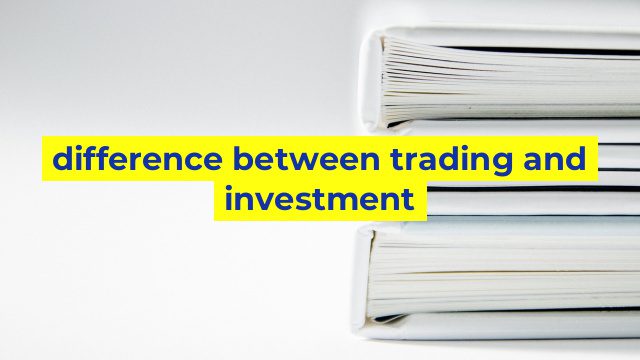The Difference Between Trading and Investment
Investing and trading are two terms that are often heard in the financial world, but there are important differences between the two. While both are methods of putting your money to work, they require different approaches and can have different outcomes. Let’s take a closer look at the difference between trading and investing.
Trading
Trading typically involves buying and selling assets with the goal of making a profit in a relatively short period of time. This can include stocks, bonds, currencies, and other financial instruments. Traders often use technical analysis and market trends to make decisions about what to buy and sell.
Trading can be high-risk and requires a lot of skill and knowledge. Successful traders often need to be able to react quickly to market changes and have a good understanding of market psychology. With the potential for quick profits also comes the potential for quick losses. Due to the high-risk nature of trading, it is generally not recommended for inexperienced investors.
Investing
Investing, on the other hand, typically involves buying and holding assets for the long term with the goal of generating a return over a period of years or decades. This can include stocks, bonds, real estate, and other assets. Investors often rely on fundamental analysis and a long-term view of market trends to make decisions about what to buy and hold.
Investing can still involve risks, but they are often lower than those associated with trading. With a long-term approach, investors can ride out short-term market fluctuations and focus on the potential for long-term gains. Investing is often recommended for individuals who are looking to grow their wealth over the long term.
The Bottom Line
While both trading and investing can be effective ways to put your money to work, they require different strategies and come with different levels of risk. Trading can be a high-risk, high-reward strategy that requires a lot of skill and experience. Investing can be a lower-risk way to grow your wealth over the long term, but it requires a long-term perspective and patience.
Ultimately, the choice between trading and investing comes down to your individual goals, risk tolerance, and experience level. Whatever strategy you choose, it’s important to do your research and have a solid plan in place to maximize your returns and minimize your risks.
Table difference between trading and investment
| Trading | Investment |
|---|---|
| Short-term approach to buying and selling assets | Long-term approach to buying and holding assets |
| Focuses on capitalizing on market fluctuations to make profits | Focuses on creating wealth over time through growth, dividends, and interest |
| Requires active management and monitoring of trades | Can be managed passively with a buy-and-hold strategy |
| Can involve higher risks due to short-term fluctuations | Generally involves lower risks due to a long-term outlook |
| Typically involves higher transaction costs and taxes | Can involve lower transaction costs and taxes due to longer holding periods |

